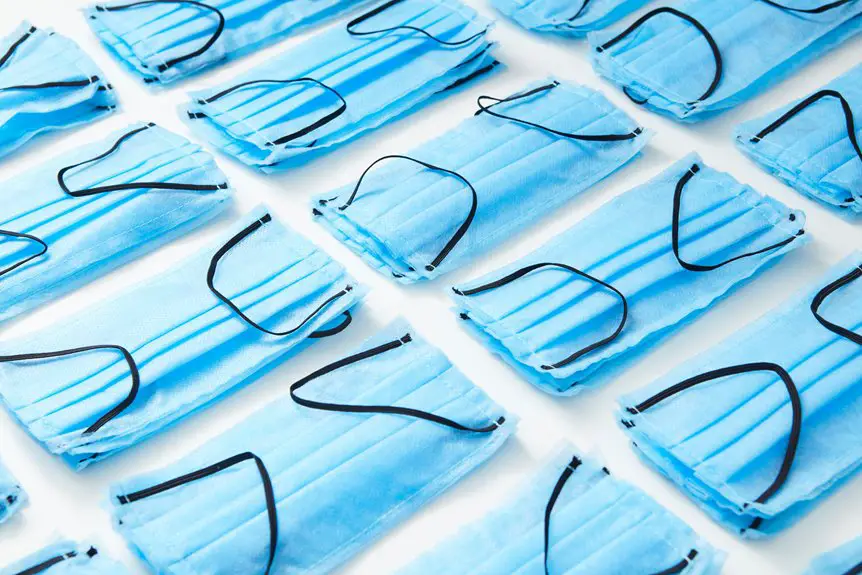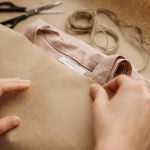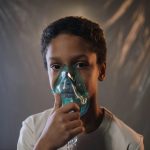You can trust polypropylene fabric for face masks because it’s lightweight, breathable, and blocks airborne particles effectively through a combination of mechanical and electrostatic filtration. It resists moisture, reduces heat buildup, and is hypoallergenic, making it safe and comfortable for extended wear. Plus, certified polypropylene masks usually meet safety standards for reliable protection. If you want to understand how it stacks up against other materials and what to look for in quality masks, there’s more to explore.
Table of Contents
Key Takeaways
- Polypropylene fabric offers excellent filtration using mechanical and electrostatic mechanisms, effectively trapping particles while remaining breathable and comfortable.
- It is lightweight, moisture-resistant, and naturally odor-resistant, making masks dry and comfortable for extended wear.
- Polypropylene masks are hypoallergenic and reduce skin irritation risks, suitable for sensitive skin.
- Masks should be certified (ASTM, EN, NIOSH) and well-fitted with adjustable features to ensure optimal safety and filtration efficiency.
- Although effective, polypropylene masks are non-biodegradable, so choosing high-quality, reusable options helps minimize environmental impact.
What Is Polypropylene Fabric?
Polypropylene fabric is a type of plastic-based textile known for its durability and lightweight properties. When you handle it, you’ll notice it feels smooth and slightly waxy.
This fabric is made from a thermoplastic polymer, which means it melts and reshapes under heat, making it easy to manufacture into various forms. You’ll find polypropylene in everything from reusable shopping bags to outdoor gear because it resists moisture, stains, and chemicals.
It’s also breathable, so it doesn’t trap heat or sweat against your skin. Plus, polypropylene is naturally odor-resistant and doesn’t absorb water, keeping you comfortable during extended wear.
If you want a fabric that combines strength and comfort without weighing you down, polypropylene is a smart choice.
How Polypropylene Fabric Works in Face Masks
You’ll find polypropylene fabric filters particles using a fine mesh of fibers that trap contaminants effectively.
At the same time, it allows air to pass through easily, so you won’t feel restricted while wearing the mask.
This balance between filtration and breathability is what makes polypropylene ideal for face masks.
Filtration Mechanism Explained
Although face masks come in various materials, the unique structure of polypropylene fabric makes it especially effective at filtering out airborne particles. This fabric uses a combination of mechanical and electrostatic filtration. The fine fibers create a dense web that traps larger particles, while static charges attract smaller particles like viruses and bacteria, preventing them from passing through. This dual action enhances filtration efficiency without considerably reducing airflow.
| Filtration Mechanism | Description |
|---|---|
| Mechanical | Fibers physically block particles |
| Electrostatic | Charges attract tiny particles |
| Fiber Density | Increases particle capture |
| Layering | Multiple layers improve filtering |
| Particle Size Range | Captures from large to tiny |
You get reliable protection thanks to these combined effects.
Breathability and Comfort
Because masks need to balance protection with ease of breathing, the fabric’s design plays an essential role in comfort.
Polypropylene fabric is lightweight and has a non-woven structure, allowing air to pass through easily while still filtering particles. When you wear a mask made from polypropylene, you’re less likely to feel suffocated or overheated compared to heavier materials.
The fabric’s moisture-wicking properties help keep your face dry by directing sweat away, which adds to your comfort during extended use. Plus, polypropylene doesn’t irritate your skin, so you can wear it for hours without discomfort.
Benefits of Using Polypropylene in Masks
When you choose a mask made with polypropylene fabric, you get a material that’s lightweight, breathable, and highly effective at filtering particles.
Polypropylene’s unique structure allows it to trap tiny droplets and aerosols, reducing the risk of inhaling harmful contaminants. You’ll also appreciate that it resists moisture buildup, keeping your mask dry and comfortable during extended wear.
Because polypropylene is durable, your mask maintains its protective qualities even after multiple uses, as long as you follow care instructions.
Additionally, the fabric’s affordability means you can invest in quality masks without breaking the bank.
Comparing Polypropylene to Other Mask Materials
While many materials are used in face masks, polypropylene stands out for its balance of filtration efficiency, breathability, and durability.
Unlike cotton, which offers comfort but lower filtration, polypropylene’s non-woven structure traps more particles without making it hard to breathe.
Compared to polyester, polypropylene generally provides better filtration and resists moisture buildup, which helps maintain effectiveness during use.
Materials like silk have some natural antimicrobial properties but don’t match polypropylene’s consistent filtration performance.
You’ll also find that polypropylene is lighter and less bulky than some denser fabrics, making it more comfortable for extended wear.
Safety Considerations for Polypropylene Masks
When choosing a polypropylene mask, you want to make sure it offers good breathability and comfort for all-day wear.
You’ll also appreciate that polypropylene is hypoallergenic, reducing the risk of skin irritation.
Most importantly, check that the mask provides reliable filtration efficiency to keep you safe.
Breathability and Comfort
Although polypropylene fabric offers excellent filtration, you’ll want to guarantee your mask remains breathable and comfortable for extended wear.
Polypropylene’s lightweight and non-woven structure helps air pass through easily, reducing resistance when you breathe. This means you won’t feel suffocated or overly warm during use, making it practical for daily activities.
However, masks made from multiple dense layers might restrict airflow, so look for designs balancing filtration with ventilation.
Adjustable features like nose wires and ear loops can improve fit and comfort, preventing irritation or slipping.
Remember, a well-fitting, breathable mask encourages consistent use, which is key for protection.
Hypoallergenic Properties
Polypropylene fabric offers hypoallergenic qualities that make it a safe choice for most people. If you have sensitive skin or allergies, you’ll appreciate that polypropylene is less likely to cause irritation compared to natural fibers like wool or some cotton blends.
This synthetic material doesn’t trap moisture as much, reducing the chance of bacterial growth that can trigger skin reactions. However, if you’re prone to chemical sensitivities, be aware that some polypropylene masks may contain additives or dyes, so it’s best to check product details or opt for masks labeled hypoallergenic.
Filtration Efficiency Safety
Since face masks play an important role in protecting you from airborne particles, understanding the filtration efficiency of polypropylene fabric is crucial.
Polypropylene’s tightly woven fibers and electrostatic properties help capture droplets, bacteria, and some viruses effectively. However, not all polypropylene masks offer the same level of protection. You should check if the mask meets recognized standards like ASTM or NIOSH to guarantee reliable filtration.
Also, keep in mind that mask fit impacts safety—gaps allow particles in, reducing efficiency. While polypropylene is generally safe, avoid masks with added chemicals or dyes that could cause irritation.
Environmental Impact of Polypropylene Masks
When you consider the widespread use of masks during recent years, their environmental footprint becomes hard to ignore. Polypropylene masks, though effective, contribute to plastic waste since they aren’t biodegradable. You’ll notice discarded masks accumulating in landfills and oceans, posing risks to wildlife. However, their lightweight nature means less material per mask compared to other plastics.
| Aspect | Polypropylene Masks | Environmental Concern |
|---|---|---|
| Material | Non-biodegradable plastic | Persists in environment |
| Waste Volume | High due to mass usage | Landfill and marine pollution |
| Recyclability | Limited recycling options | Often discarded improperly |
| Wildlife Impact | Can entangle or be ingested | Threatens animals |
Being aware helps you make eco-conscious decisions about mask use and disposal.
Tips for Choosing Quality Polypropylene Face Masks
Understanding the environmental impact of masks highlights why choosing high-quality polypropylene face masks matters. When selecting one, look for masks labeled as medical-grade or with multiple layers, as these offer better filtration.
Check if the mask fits snugly without gaps around your nose and chin to maximize protection. Avoid masks that feel flimsy or look poorly made—they’re less effective and wear out quickly.
Also, consider masks that include adjustable ear loops or nose wires for a customized fit. Quality polypropylene masks often come with certifications or meet standards like ASTM or EN, so verify these if possible.
Finally, pick masks that balance breathability and filtration to stay comfortable during extended use. Choosing wisely helps protect you and reduces environmental waste.
Frequently Asked Questions
Can Polypropylene Fabric Be Recycled After Mask Use?
You can recycle polypropylene fabric after mask use, but it depends on local facilities. Make sure the mask is clean and dry, then check if your recycling program accepts this material to avoid contamination or rejection.
How Long Can a Polypropylene Mask Be Safely Worn?
Think of your polypropylene mask like a sponge; after about 8 hours of wear, it soaks up moisture and loses effectiveness. You shouldn’t wear it longer than that before replacing or sanitizing it for safety.
Does Polypropylene Cause Skin Irritation or Allergies?
You typically won’t experience skin irritation or allergies from polypropylene since it’s hypoallergenic and gentle. However, if you have sensitive skin, you might feel mild irritation, so it’s best to monitor your skin’s reaction.
Can Polypropylene Masks Be Washed and Reused?
About 60% of polypropylene masks lose filtration efficiency after washing. You can’t reliably wash and reuse them, so it’s best to use new ones for protection. Reusing reduces effectiveness and risks exposure.
Are Polypropylene Masks Effective Against COVID-19 Variants?
You’ll find polypropylene masks effective against COVID-19 variants because they filter airborne particles well. Just remember, wearing them properly and combining with other precautions boosts your protection greatly against evolving strains.
- What Are the Different Types of Suede Fabric? - July 8, 2025
- What Is Ultrasuede and Why Is It So Popular? - July 8, 2025
- How Can You Tell the Difference Between Real Suede and Synthetic Suede? - July 8, 2025







